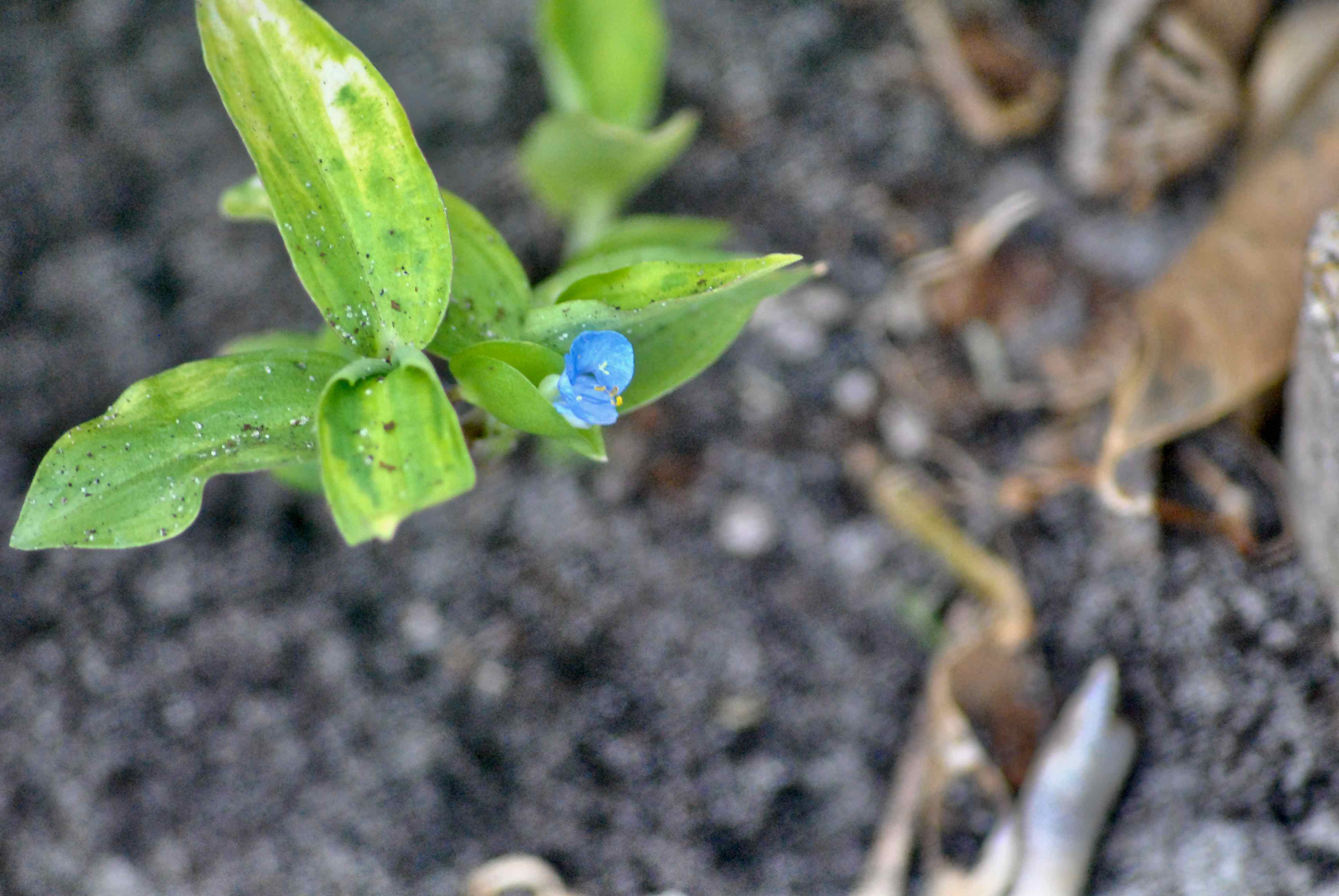
Common dayflower, photographed in Delray Beach near Lake Ida Road, Palm Beach County, in November 2014.
Common doesn't begin to describe how common common dayflower really is. The stuff, known scientifically as Commelina diffusa, is everywhere. Everywhere you look, everywhere around the globe. Or seemingly so.
It's found in throughout most of Florida, including almost all of the Peninsula, the Caribbean, Mexico, Central America and South America. It's found throughout equatorial Africa, Australia and East Asia, including India, Bhutan, Tibet, China, the Koreas, Vietnam, Malaysia, the Phillipines and more.
In the United States, common dayflower is found as far north as New York and Vermont, west to Kansas, Oklahoma and Texas. According to most sources, including the Institute for Regional Conservation and the Atlas of Florida Vascular Plants, common dayflower is a native of the "old world" introduced somehow to the Western Hemisphere. The U.S. Department of Agriculture has it as a native, however.
It is similar to whitemouth dayflower, Commelina erecta, a Florida native. Whitemouth dayflower has two blue petals and one white and it tends to be more upright. Common dayflower's petals are all blue and it crawls along the ground. Both are members of Commelinaceae, the dayflower family.
The leaves on common dayflower vary from lance-shaped to somewhat oval-shaped. Up north, it is an annual, but it can be a perennial in warmer climates like South Florida.
It is edible, but it does contain oxalate, according to Eat the Weeds. Mr. Green Dean says if you're going to ingest the stuff, select young plants and cook them to reduce the oxalate, a compound that can cause kidney stones.
Common dayflower is found in "disturbed" areas, including roadsides, lawns and gardens, in woods and in moist areas, including swamps and marshes. In some places, it can form floating mats.
It is a major agricultural pest and an invasive in parts of the world. It's a major problem for rice farmers in Texas. The plant's stem is jointed where leaves form; those joints also have nodes where roots can form. Break common dayflower, and new plants grow from the pieces, making it difficult to eliminate.
Common dayflower is widely used to make medicines particularly in Asia. In Malaysia, the leaves are used for treating sores; crushed leaves and stems are used for irregular menstruation. In Indonesia, stems are used to cover dirty wounds. In South America, the Guyana Patomona boil it and drink the water before hunting. It's used for hair loss, kidney disease (oddly enough), to cleanse the uterus and tubes. Bruised plants are used for burns, itches and boils The petal juice is used to make paint. Women in the Torres Strait area between Australia and New Guinea rub their hair with it.
Other names: Climbing Dayflower, Creeping Day Flower, Birdbill Dayflower, Spreading Dayflower. In Australia, it's also called scurvy weed.
It's found in throughout most of Florida, including almost all of the Peninsula, the Caribbean, Mexico, Central America and South America. It's found throughout equatorial Africa, Australia and East Asia, including India, Bhutan, Tibet, China, the Koreas, Vietnam, Malaysia, the Phillipines and more.
In the United States, common dayflower is found as far north as New York and Vermont, west to Kansas, Oklahoma and Texas. According to most sources, including the Institute for Regional Conservation and the Atlas of Florida Vascular Plants, common dayflower is a native of the "old world" introduced somehow to the Western Hemisphere. The U.S. Department of Agriculture has it as a native, however.
It is similar to whitemouth dayflower, Commelina erecta, a Florida native. Whitemouth dayflower has two blue petals and one white and it tends to be more upright. Common dayflower's petals are all blue and it crawls along the ground. Both are members of Commelinaceae, the dayflower family.
The leaves on common dayflower vary from lance-shaped to somewhat oval-shaped. Up north, it is an annual, but it can be a perennial in warmer climates like South Florida.
It is edible, but it does contain oxalate, according to Eat the Weeds. Mr. Green Dean says if you're going to ingest the stuff, select young plants and cook them to reduce the oxalate, a compound that can cause kidney stones.
Common dayflower is found in "disturbed" areas, including roadsides, lawns and gardens, in woods and in moist areas, including swamps and marshes. In some places, it can form floating mats.
It is a major agricultural pest and an invasive in parts of the world. It's a major problem for rice farmers in Texas. The plant's stem is jointed where leaves form; those joints also have nodes where roots can form. Break common dayflower, and new plants grow from the pieces, making it difficult to eliminate.
Common dayflower is widely used to make medicines particularly in Asia. In Malaysia, the leaves are used for treating sores; crushed leaves and stems are used for irregular menstruation. In Indonesia, stems are used to cover dirty wounds. In South America, the Guyana Patomona boil it and drink the water before hunting. It's used for hair loss, kidney disease (oddly enough), to cleanse the uterus and tubes. Bruised plants are used for burns, itches and boils The petal juice is used to make paint. Women in the Torres Strait area between Australia and New Guinea rub their hair with it.
Other names: Climbing Dayflower, Creeping Day Flower, Birdbill Dayflower, Spreading Dayflower. In Australia, it's also called scurvy weed.



